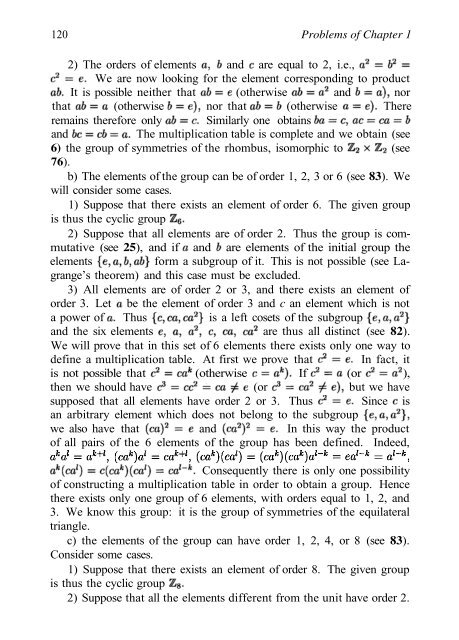Abel's theorem in problems and solutions - School of Mathematics
Abel's theorem in problems and solutions - School of Mathematics
Abel's theorem in problems and solutions - School of Mathematics
You also want an ePaper? Increase the reach of your titles
YUMPU automatically turns print PDFs into web optimized ePapers that Google loves.
120 Problems <strong>of</strong> Chapter 1<br />
2) The orders <strong>of</strong> elements <strong>and</strong> are equal to 2, i.e.,<br />
We are now look<strong>in</strong>g for the element correspond<strong>in</strong>g to product<br />
It is possible neither that (otherwise <strong>and</strong> nor<br />
that (otherwise nor that (otherwise There<br />
rema<strong>in</strong>s therefore only Similarly one obta<strong>in</strong>s<br />
<strong>and</strong> The multiplication table is complete <strong>and</strong> we obta<strong>in</strong> (see<br />
6) the group <strong>of</strong> symmetries <strong>of</strong> the rhombus, isomorphic to (see<br />
76).<br />
b) The elements <strong>of</strong> the group can be <strong>of</strong> order 1, 2, 3 or 6 (see 83). We<br />
will consider some cases.<br />
1) Suppose that there exists an element <strong>of</strong> order 6. The given group<br />
is thus the cyclic group<br />
2) Suppose that all elements are <strong>of</strong> order 2. Thus the group is commutative<br />
(see 25), <strong>and</strong> if <strong>and</strong> are elements <strong>of</strong> the <strong>in</strong>itial group the<br />
elements form a subgroup <strong>of</strong> it. This is not possible (see Lagrange’s<br />
<strong>theorem</strong>) <strong>and</strong> this case must be excluded.<br />
3) All elements are <strong>of</strong> order 2 or 3, <strong>and</strong> there exists an element <strong>of</strong><br />
order 3. Let be the element <strong>of</strong> order 3 <strong>and</strong> c an element which is not<br />
a power <strong>of</strong> Thus is a left cosets <strong>of</strong> the subgroup<br />
<strong>and</strong> the six elements are thus all dist<strong>in</strong>ct (see 82).<br />
We will prove that <strong>in</strong> this set <strong>of</strong> 6 elements there exists only one way to<br />
def<strong>in</strong>e a multiplication table. At first we prove that In fact, it<br />
is not possible that (otherwise If (or ),<br />
then we should have (or but we have<br />
supposed that all elements have order 2 or 3. Thus S<strong>in</strong>ce is<br />
an arbitrary element which does not belong to the subgroup<br />
we also have that <strong>and</strong> In this way the product<br />
<strong>of</strong> all pairs <strong>of</strong> the 6 elements <strong>of</strong> the group has been def<strong>in</strong>ed. Indeed,<br />
Consequently there is only one possibility<br />
<strong>of</strong> construct<strong>in</strong>g a multiplication table <strong>in</strong> order to obta<strong>in</strong> a group. Hence<br />
there exists only one group <strong>of</strong> 6 elements, with orders equal to 1, 2, <strong>and</strong><br />
3. We know this group: it is the group <strong>of</strong> symmetries <strong>of</strong> the equilateral<br />
triangle.<br />
c) the elements <strong>of</strong> the group can have order 1, 2, 4, or 8 (see 83).<br />
Consider some cases.<br />
1) Suppose that there exists an element <strong>of</strong> order 8. The given group<br />
is thus the cyclic group<br />
2) Suppose that all the elements different from the unit have order 2.

















